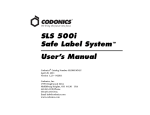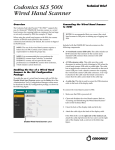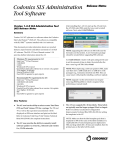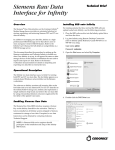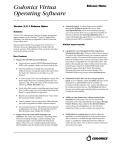Download Codonics SLS Total Dose/Total Volume
Transcript
Codonics SLS Total Dose/Total Volume Overview However, if the selected drug classification template does not support TD/TV information, the TD/TV dialog boxes described in this Technical Brief will still appear on 500i, but the label will not have any TD/TV information printed on it. This document describes how to setup and use the Total Dose/Total Volume (TD/TV) drug preparation method with the Codonics Safe Label System™ (SLS). This document explains: Technical Brief ◆ ◆ How Administration Tool (AT) users can enter TD/TV information for drugs in a formulary TD/TV information is not encoded in the syringe barcode. ◆ ◆ How SLS 500i™ users can select TD/TV entries on 500i to provide printed syringe labels with TD/TV information The TD/TV function is only supported for single drugs in the formulary. It is not supported for combination drugs. ◆ Administer Mode will only announce the drug name and equivalent concentration, but not the TD/TV values. SLS Drug Preparation Methods There are two preparation methods for managing how drugs are labeled: Normal Dilution and TD/TV. The Normal Dilution method is commonly used in OR environments where the amount and frequency of drug administration can vary. Since the total dose being administered might not be known ahead of time, the primary information required on the syringe label is the drug name and prepared concentration. TD/TV is commonly used when an order or prescription for a drug is issued and the drug is prepared according to the instructions in the order. TD/TV is also used in applications involving infusion pumps. Drugs prepared in this manner include the drug name, the total dose to be administered, and the total volume of the drug and diluent in the final preparation. 500i also includes the equivalent concentration of the preparation on the label for regulatory compliance. On the AT— Setting the Always Show TD/TV Option The Always Show TD/TV option, which is located on the Safety tab of the AT’s Configuration Manager section, controls when the TD/TV prompt displays during the label printing procedure on 500i. NOTE: The Always Show TD/TV option applies only to drugs that are assigned the TD/TV preparation method. For drugs that are assigned the Normal Dilution preparation method, the prompt for dilutions and diluents works as described in the SLS User’s Manual. SLS allows multiple TD/TV preparations to be associated with each drug. The preparations are set up using the AT and included as part of the SLS formulary. When a drug container is scanned on 500i, the user can select from the TD/TV preparations associated with that drug. Notes About the TD/TV Preparation Method Note the following about the TD/TV preparation method: ◆ The TD/TV information will be printed on labels that support it [for example, 30 x 80-mm Japan labels (JP-L1_vxx)] and shown on any applicable previews. Always Show TD/TV option ® ◆ If the Always Show TD/TV option is selected (the default), the TD/TV prompt will always display during the label printing procedure on 500i. ◆ If the Always Show TD/TV option is deselected, then the TD/TV prompt will not display if there is only one TD/TV entry and one diluent. In that case, the procedure will go directly to displaying or printing the label. 3. In the Dilution Status list, select the dilution status: Allowed, Not Allowed, or Required. To disable the Always Show TD/TV option, you must deselect the option, create a configuration package, and deploy the configuration to each 500i. On the AT— Specifying TD/TV Entries for a Drug in the Formulary The following procedure covers only the drug formulary settings that are specific to TD/TV. For more information about other drug formulary settings, refer to the SLS Administration Tool User’s Manual. 1. Select the Label Template Pack that you want to create for the specific formulary. All Label Template Packs support TD/TV if the drug's preparation method is set to TD/TV: ◆ The JP-L1 Label Template Pack supports printing of TD/TV on the label. ◆ The JP-S1 and STD-1 Label Template Packs will show TD/TV on the 500i user interface but not print TD/TV on the label. Dilution Status list 4. In the Preparation Method list, select Total Dose/Total Volume. For more information about the Label Template Packs, refer to the Codonics SLS Administration Tool Localization Enhancements Technical Brief (part number 901-261-001). 2. With the formulary drug list displayed, click the drug record’s Edit icon. Edit icon Total Dose/Total Volume selected in the Preparation Method list 5. Click the Total Dose/Total Volume Edit button. The Editing Formulary Drug(s) dialog box displays. The Set Total Dose/Total Volume dialog box displays. ® 2 The new entry is added to the list. If the TD/TV entries that you want to use are listed, go to step 7. If the TD/TV entries that you want to use are not listed, you can add them. Go to step 6. 6. To add a TD/TV entry: a. Select the values and units for the new entry in the Total Dose and Total Volume number and units lists. Values and units selected in lists d. Create additional entries as needed. 7. Select the check boxes for the TD/TV entries that apply to the drug. 8. To save your selections, click the Save Total Dose/Total Volume button. The selected TD/TV entries are displayed in the Editing Formulary Drug(s) dialog box. The number lists include an Other option to create an Other TD/TV entry. An Other TD/TV entry allows you to specify only the combination of TD/TV units. For an Other entry, a 500i user will enter the values for the TD/TV unit combination when creating the label. b. c. To allow TD/TV and equivalent concentrations to be highlighted in cases for which there is a non-standard equivalent concentration that should be alerted on the 500i user interface and on printed labels, select the Highlight check box. Click the Add Total Dose/Total Volume button. 9. Enter the other formulary information required for the drug. 10. Click the Save button to save the formulary drug information. The TD/TV information is displayed in the Total Dose/Total Volume column in the drug list. ® 3 11. When you have finished entering information for the drugs in the formulary, create a formulary package and deploy it to 500i. For more information, refer to the SLS Administration Tool User’s Manual. 3. Press and/or drag the Dose/Volume list until the appropriate TD/TV entry and equivalent concentration is selected (that is, it is displayed under the blue highlighted bars). 4. Press and/or drag the Diluent list until the appropriate diluent is selected. On 500i— Entering TD/TV Values for a Syringe Label For drugs in the formulary whose preparation method was specified as TD/TV, you will automatically be prompted to enter the TD/TV values when printing a syringe label. 1. Before scanning the drug container barcode, if the intent is to dilute the drug, set the Dilute switch to on. ◆ If the dilution status for the drug is Not Allowed, the only option in the Diluent list will be None. ◆ If the dilution status for the drug is Allowed, a None option is included at the bottom of the Diluent list. ◆ If the dilution status for the drug is Required, a None option is not included in the Diluent list. 5. To save your selections, press the OK button. If you did not select an Other TD/TV option, then continue in the label printing workflow, as described in the SLS User’s Manual. If you selected an Other TD/TV option, you are prompted to enter the dose and volume values. Dilute switch on position 2. Scan the drug container barcode. NOTE: The drug will follow the verification steps, as described in the SLS User’s Manual. After the drug is identified, the prompt for the TD/TV entries displays. 6. Enter the TD/TV values in the Total Dose and Total Volume fields. As you enter the values, the system computes the equivalent concentration and displays it in the Equivalent Concentration field. 7. To save the value entries, click the OK button. ® 4 You can continue in the label printing workflow, as described in the SLS User’s Manual. The formulary settings for this drug on the Editing Formulary Drug(s) dialog box in the AT are shown below. Examples of TD/TV Prompt Behavior The following examples show the TD/TV prompt behavior on 500i during the label printing procedure. The examples are based on the drug’s Dilution setting and TD/TV entries, as specified in the AT. These are examples only; they do not represent an actual drug situation. The examples are intended to represent how the TD/TV works and its behavior in the AT and 500i. NOTE: If the TD/TV equivalent concentration is within 1% of the original container concentration, the system considers the TD/TV to be equivalent to the original concentration. Otherwise, the system considers the TD/TV to be a dilution. For example, if the original container concentration is 0.3 g but the TD/TV entry is 0.333, then they are considered different and 0.333 is considered a dilution. A warning will be displayed for the relevant AT and 500i use cases. Example 1 For this example: ◆ The drug is Morphine. ◆ The Always Show TD/TV configuration option on the Safety tab of the AT’s Configuration Manager section was selected. ◆ The original drug container concentration is 10 mg/mL. ◆ The dilution status is set to Allowed. ◆ The available diluents are Normal Saline, Sterile Water, and Other. ◆ The TD/TV entries include multiples of the original container concentration and dilutions of the original concentration: ◆ ◆ ◆ ◆ ◆ ◆ 10 mg/1 mL 10 mg/10 mL 10 mg/20 mL 10 mg/100 mL 20 mg/2 mL Other mg/mL On 500i: ◆ If the Dilute switch is set to Off, the TD/TV prompt will display as follows: No diluted TD/TV entries or diluents will be shown because the Dilute switch is set to off. Only TD/TV entries with concentrations that are equivalent to the original concentration (for example, 10 mg/mL) are displayed and no diluents are displayed. ◆ If the Dilute switch is set to On, the TD/TV prompt will display as follows: ® 5 Only TD/TV entries that are dilutions of 10 mg/mL are displayed and the diluents are displayed. Example 2 For this example: ◆ The drug is Heparin. ◆ The Always Show TD/TV configuration option on the Safety tab of the AT’s Configuration Manager section was selected. ◆ The original drug container concentration is 10,000 Units/mL. ◆ The dilution status is set to Not Allowed. ◆ There are no available diluents. ◆ The TD/TV entries include multiples of the original concentration, dilutions of the original concentration, and an Other entry: ◆ ◆ ◆ ◆ ◆ ◆ 10,000 Units/1 mL 10,000 Units/2 mL 20,000 Units/2 mL 20,000 Units/4 mL 40,000 Units/4 mL Other Units/mL The initial formulary settings for this drug on the Editing Formulary Drug(s) dialog box in the AT are shown below. However, because dilutions are not allowed, the following prompt would be displayed after selecting TD/TV entries that represent dilutions of the original container concentration: If dilutions are not intended to be included, the entries listed in the Warning message should be removed. If dilutions are intended to be included, then the Dilution Status should be changed to Allowed. The following example shows the dilution entries removed to resolve the problem. ® 6 Example 3 If the Warning shown in example 2 is ignored and a TD/TV entry is a dilution but the Dilution setting is Not Allowed, then the 500i user will be able to choose a dilution but no diluents will be displayed. You should be aware that this configuration overrides the intention of not allowing dilutions. If no changes were made to the original TD/TV entries or dilution status, on 500i: ◆ If the Dilute switch is set to Off, the TD/TV prompt will display as follows: Example 4 For this example: ◆ The drug is Atropine. ◆ The Always Show TD/TV configuration option on the Safety tab of the AT’s Configuration Manager section was selected. ◆ The original drug container concentration is 0.5 mg/mL. ◆ The dilution status is set to Required. ◆ The available diluents are Normal Saline and Sterile Water. ◆ The TD/TV entries include multiples of the original container concentration, dilutions of the original concentration, and an Other entry: ◆ No dilution values of 10,000 Units/mL will be shown. Only TD/TV entries that are equivalent to the original container concentration of 10,000 Units/mL are displayed (for example, 20,000 Units/2 mL), and no diluents are displayed. ◆ If the Dilute switch is set to On, the following prompt that indicates that dilutions are not allowed is displayed: ◆ ◆ ◆ ◆ ◆ ◆ 0.25 mg/10 mL 0.5 mg/1 mL 0.5 mg/5 mL 0.5 mg/10 mL 0.5 mg/50 mL 1 mg/2 mL Other mg/mL The initial formulary settings for this drug on the Editing Formulary Drug(s) dialog box in the AT are shown below. ® 7 However, because dilutions are required, the following prompt would be displayed after selecting TD/TV entries that are equivalent to the original container concentration: Based on the final settings shown above, on 500i the following TD/TV prompt displays regardless of whether the Dilute switch is set to Off or On: To correct this condition, the values listed in the Warning message should be removed, so that the final settings are as shown below. Only TD/TV entries that are dilutions are displayed, and the diluents are displayed. ® 8 Example 5 For this example: ◆ The drug is Morphine. ◆ The Always Show TD/TV configuration option on the Safety tab of the AT’s Configuration Manager section was selected. ◆ The original drug container concentration is 10 mg/mL. ◆ The dilution status is set to Allowed. ◆ The available diluents are Normal Saline and Sterile Water. ◆ The TD/TV entries include multiples of the original container concentration, a concentration that is higher than the original concentration, dilutions of the original concentration, and an Other entry: ◆ ◆ ◆ ◆ ◆ ◆ To correct this condition, the higher concentration entry listed in the Warning message should be removed, so that the final settings are as shown below. 10 mg/1 mL 10 mg/10 mL 10 mg/20 mL 10 mg/100 mL 20 mg/1 mL Other mg/mL The initial formulary settings for this drug on the Editing Formulary Drug(s) dialog box in the AT are shown below. On 500i: ◆ However, because the 20 mg/1 mL entry has a concentration that is higher than the original container concentration, the following prompt would be displayed after selecting the TD/TV entries: If the Dilute switch is set to Off, the TD/TV prompt will display as follows: Only TD/TV entries whose concentration is equivalent to the original container concentration are displayed, and no diluents are displayed. ® 9 ◆ If the Dilute switch is set to On, the following prompt that indicates that dilutions are allowed is displayed: Example 6 For this example: ◆ The drug is Morphine. ◆ The Always Show TD/TV configuration option on the Safety tab of the AT’s Configuration Manager section was not selected. On 500i: NOTE: The Always Show TD/TV configuration option applies to all drugs in the formulary. ◆ The original drug container concentration is 10 mg/mL. ◆ The dilution status is set to Allowed. ◆ The available diluents are Normal Saline, Sterile Water, and Other. ◆ The TD/TV entries include a concentration that is equivalent to the original container concentration and a dilution: ◆ 10 mg/1 mL ◆ 10 mg/10 mL The formulary settings for this drug on the Editing Formulary Drug(s) dialog box in the AT are shown in the screen at the top of the next column. ◆ If the Dilute switch is set to Off, the TD/TV entry whose concentration is equivalent to the original container concentration will be automatically selected because it is the only non-diluted concentration defined for the drug. A TD/TV prompt is not displayed. ◆ If the Dilute switch is set to On, the TD/TV prompt will display as follows: The prompt is displayed because, even though there is only one dilution value, multiple diluents have been selected for the drug. If only one diluent had been selected, then the dilution and diluent would have been automatically selected by the system and no prompt would have been displayed. ® 10 Example 7 On 500i, if the Dilute switch is set to Off, only the Other entry will be displayed in the TD/TV prompt: For this example: ◆ The drug is Morphine. ◆ The Always Show TD/TV configuration option on the Safety tab of the AT’s Configuration Manager section was selected. ◆ The original drug container concentration is 10 mg/mL. ◆ The dilution status is set to Allowed. ◆ The available diluents are Normal Saline and Sterile Water. ◆ The only TD/TV entry is Other mg/mL. The formulary settings for this drug on the Editing Formulary Drug(s) dialog box in the AT are shown below. If the Dilute switch is set to On and the user selects a TD/TV entry whose concentration is equivalent to the original container concentration (for example, 20 mg/2 mL), the system will display the following message to indicate that the entered TD/TV might not be a dilution: Technical Support If problems occur when using the SLS system, contact Codonics Technical Support. Phone: Email: Website: Get it all with just one call 800.444.1198 All registered and unregistered trademarks are the property of their respective owners. Specifications subject to change without notice. Patents pending. Copyright © 2012 Codonics, Inc. Printed in the U.S.A. Part No. 901-259-001.02. +1.440.243.1198 [email protected] www.codonics.com ® 17991 Englewood Drive Middleburg Heights, OH 44130 USA +1.440.243.1198 +1.440.243.1334 Fax Email [email protected] www.codonics.com Codonics Limited KK New Shibaura Bldg. F1 1-3-11, Shibaura Minato-ku, Tokyo, 105-0023 JAPAN Phone: 81-3-5730-2297 Fax: 81-3-5730-2295











